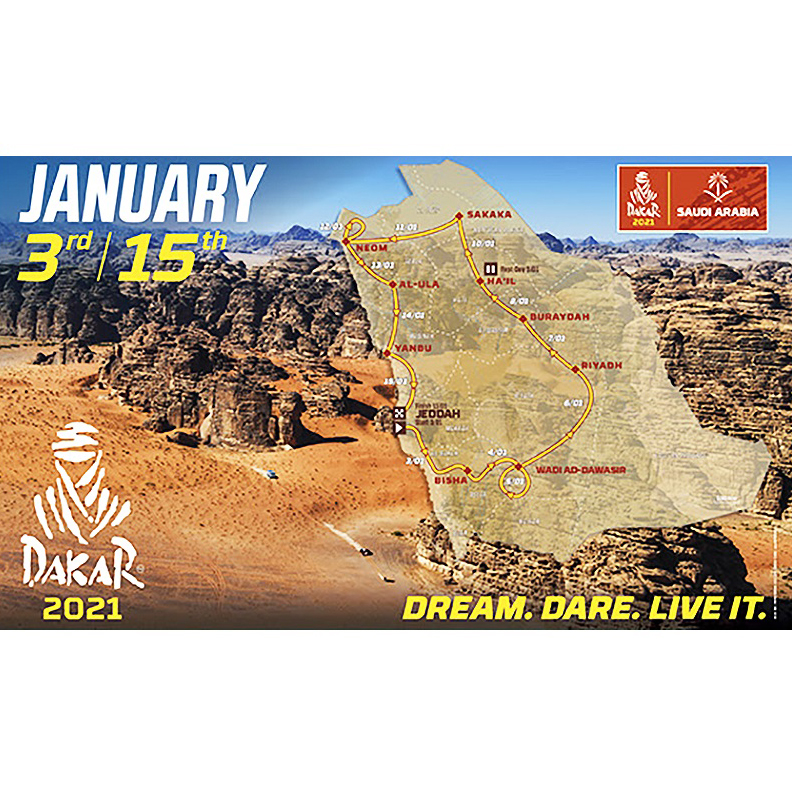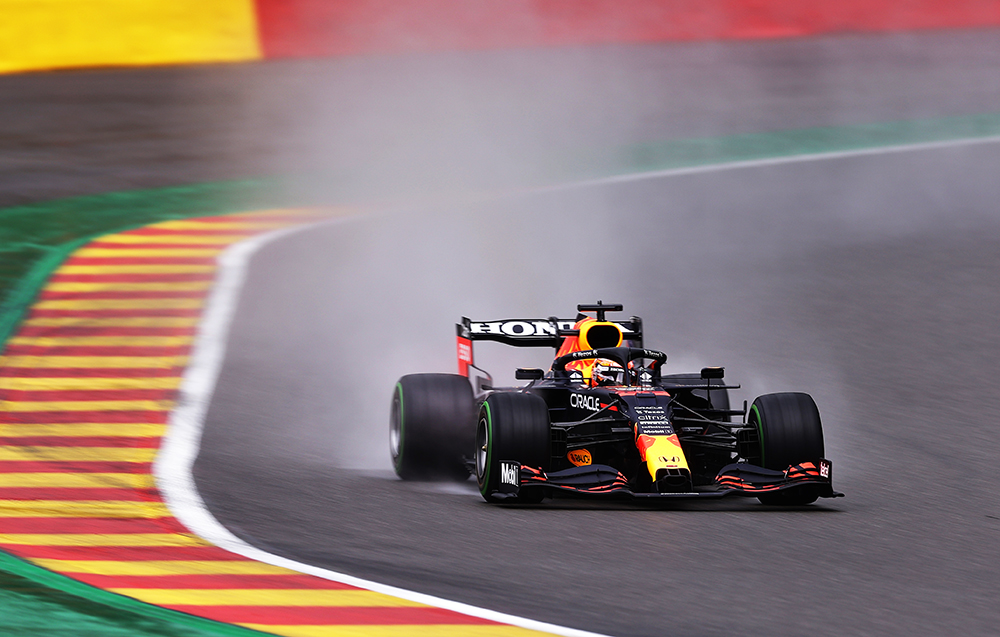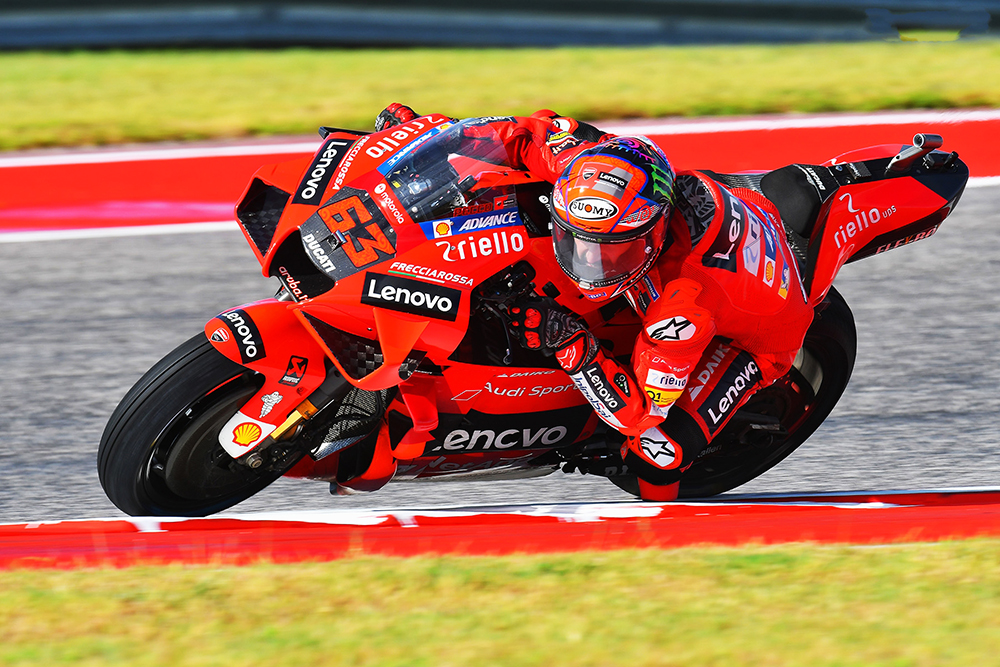Voilà les détails du parcours de la 43e édition du Dakar, qui se tiendra en Arabie Saoudite du 3 au 15 janvier prochains. Un tracé de 7 646 km avec départ et arrivée à Jeddah, comprenant 4 767 km de spéciales, permettra aux pilotes de se départager et de poursuivre l’exploration des déserts saoudiens entamée l’année dernière.
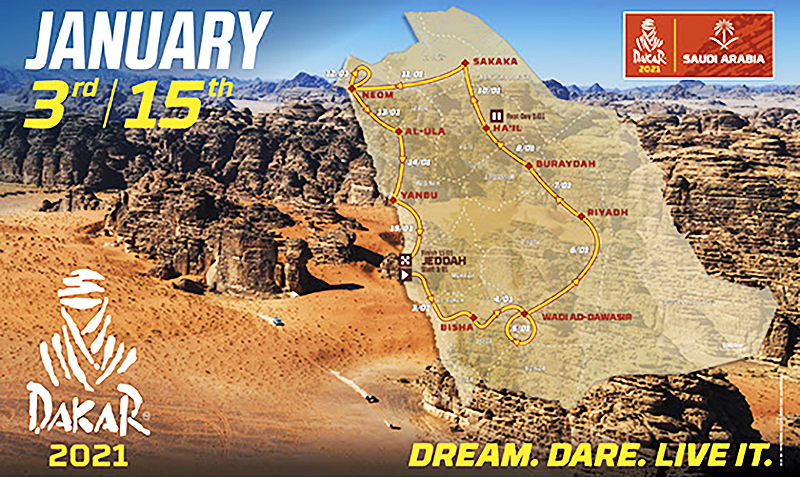
Le parcours 2021, totalement inédit en ce qui concerne les spéciales, s’est attaché à diminuer la longueur et la quantité des portions roulantes, privilégiant la technique de pilotage, le franchissement et la navigation. Une étape marathon éprouvera les qualités de gestion et d’endurance des concurrents, immédiatement après la journée de repos à Ha’il.
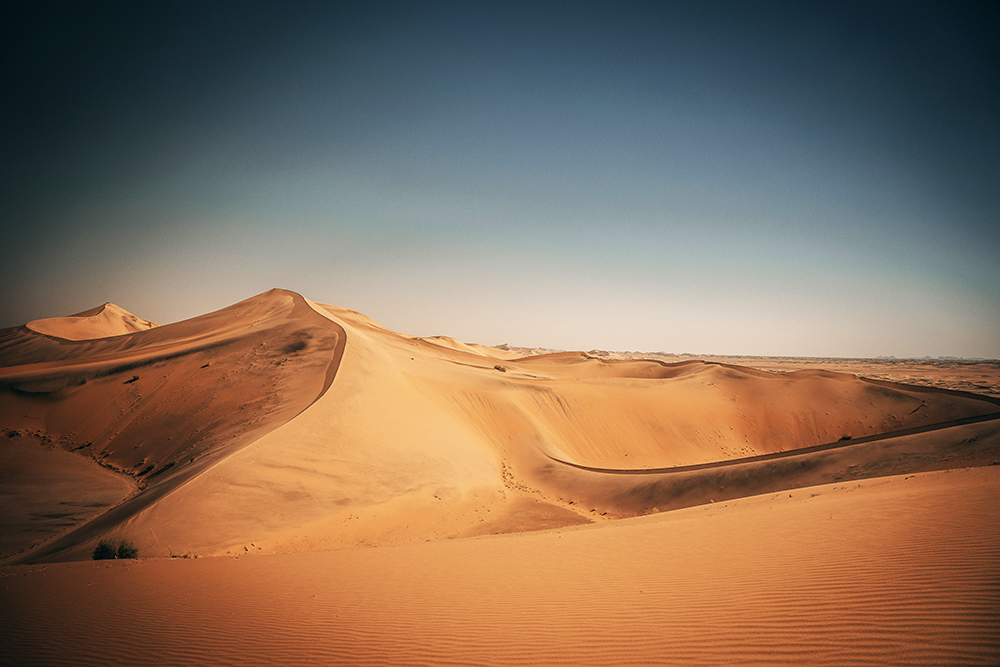
En dépit des difficultés liées à la crise sanitaire, les pilotes et équipages de 321 véhicules ont répondu présents au rendez-vous : 108 motos, 21 quads, 124 autos et SSV, 42 camions et 26 véhicules inscrits pour une course de régularité dans la nouvelle catégorie « Dakar Classic », ouverte aux autos et camions du siècle dernier.
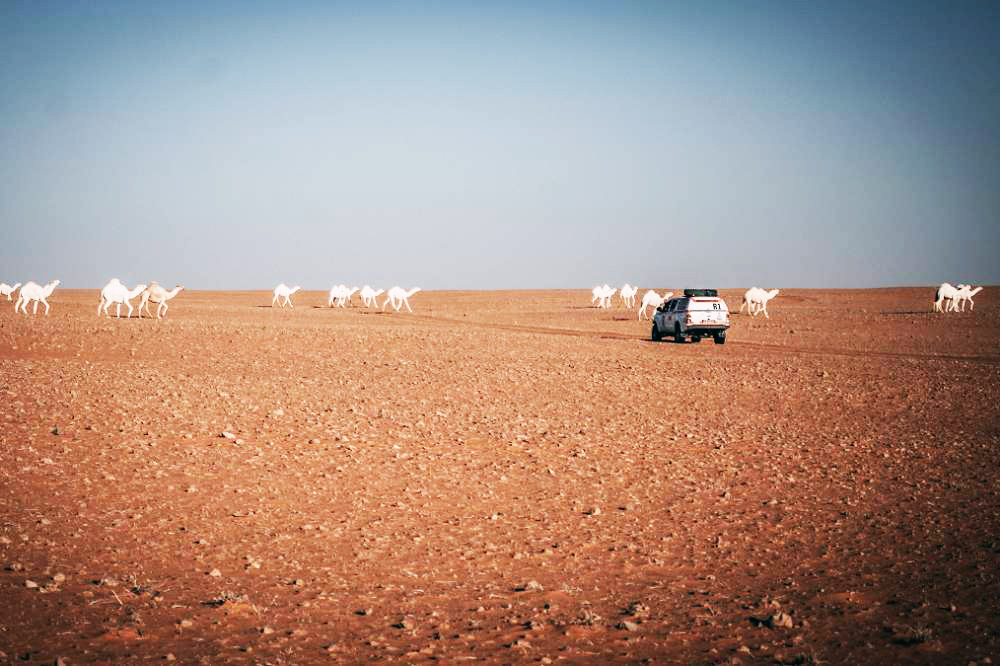
On entend souvent que prendre le départ du Dakar représente déjà une victoire. C’est certainement ce sentiment qui nous animera tous le 3 janvier à Jeddah », a souligné David Castera en ouverture de la présentation du Dakar 2021. Le travail de préparation, et en particulier les reconnaissances, a dû être effectué selon un calendrier adapté aux contraintes de déplacement de l’année 2020. De même, la course se tiendra dans des conditions inhabituelles rédigées dans un protocole visant à assurer une protection maximale contre la circulation du virus Covid-19. Mais pour les passionnés de rallye raid, l’épreuve reine du mois de janvier comportera bien les ingrédients qui « font vibrer ceux qui partent et font rêver ceux qui restent », pour reprendre la recette de son créateur, Thierry Sabine.
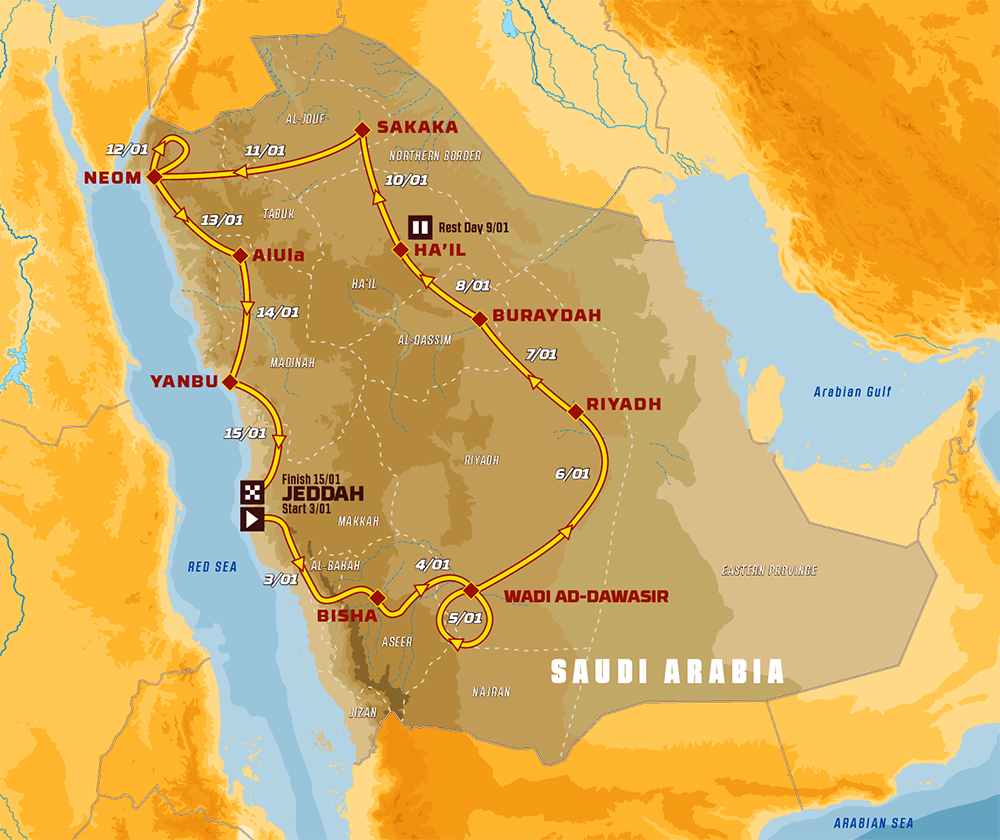
Après une initiation aux déserts saoudiens, c’est une leçon de géographie encore plus poussée que prendront les pilotes et équipages du Dakar 2021. Les caractéristiques du parcours ainsi que les nouvelles réglementations adoptées visent à réduire la vitesse moyenne, pour améliorer encore les conditions de sécurité et pour valoriser les qualités sportives des concurrents. Précisément, la lutte pour les différents titres en jeu devrait mettre en concurrence les pilotes de pointe habitués à batailler au sommet des classements. À moto, Ricky Brabec a mis fin avec Honda à une série de 18 victoires consécutives pour la firme autrichienne KTM, qui aura à nouveau les arguments pour tenter de se hisser à nouveau au sommet, tandis que la catégorie quads est privée de son tenant du titre Ignacio Casale, engagé pour un nouveau défi en camion, la catégorie par laquelle il avait découvert le Dakar en 2010. Carlos Sainz, vainqueur 2020 en autos au volant d’un buggy Mini X-Raid, se lance avec la même ambition mais peut-être pas avec la réussite qui lui avait permis de contrôler la menace de Nasser Al Attiyah chez Toyota.
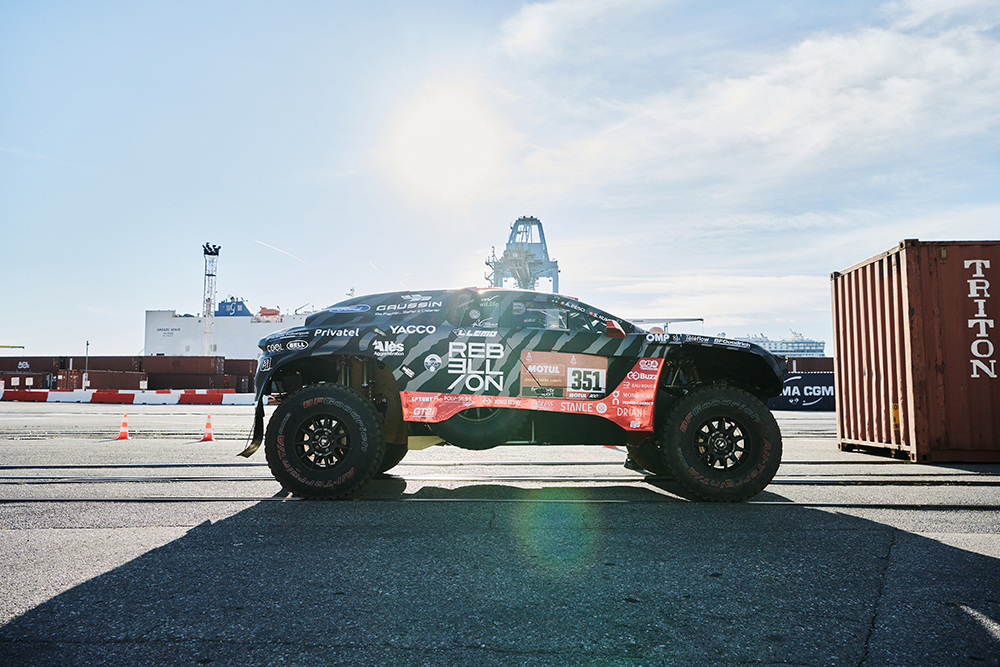
Déjà vive chez les deux constructeurs favoris, la concurrence sera densifiée par le retour de Sébastien Loeb, engagé comme Joan « Nani » Roma dans le team privé BRX, et pourquoi pas du côté du duo constitué de Cyril Despres et Mike Horn, lancés dans un projet de véhicule à énergie alternative pour le Dakar. Enfin, en SSV, c’est le vainqueur chilien de 2019 Francisco « Chaleco » Lopez qui fera figure de favori, dans une discipline où la hiérarchie est toutefois en perpétuel renouvellement.
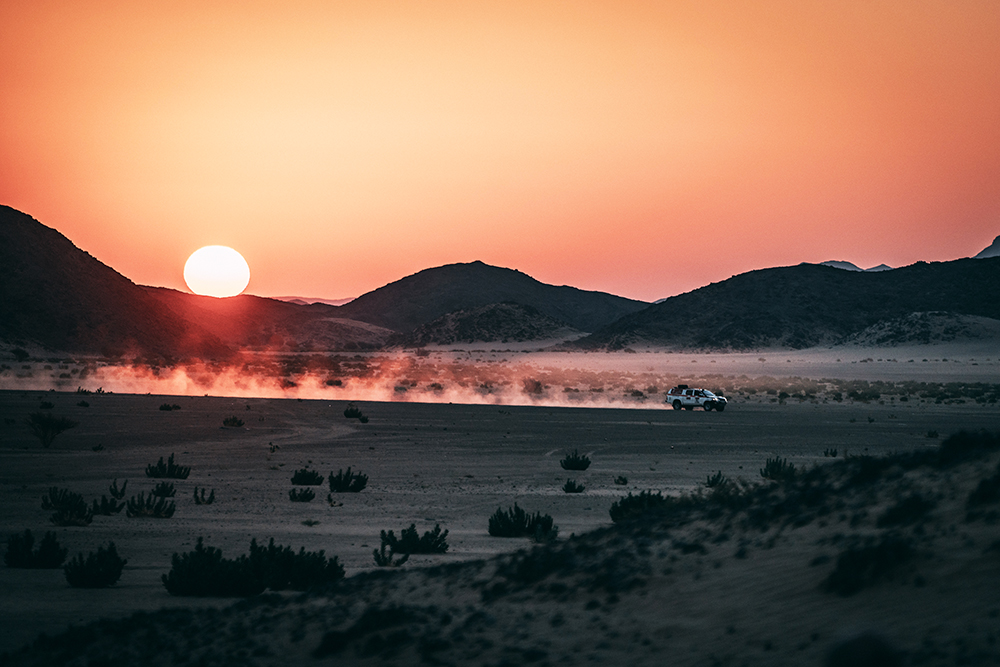
Si les acteurs du Dakar entreront en piste dès le 2 janvier pour un court prologue (11 km) dont l’intérêt consistera à attribuer à chacun un ordre de départ pour la première étape correspondant à sa valeur sportive du moment, ils devront auparavant passer par plusieurs échéances intermédiaires d’ici-là. La plupart des véhicules seront en effet convoqués à Marseille les 1er, 2 et 3 décembre pour un embarquement sur un cargo, direction Jeddah. Les retrouvailles en bord de Mer Rouge avec les propriétaires se feront les 30 et 31 décembre, tandis que les vérifications techniques et administratives seront organisées les 1er et 2 janvier… dans le respect des règles de protection sanitaire, comme l’exige l’époque.
Le Dakar arrive
Les prochains rendez-vous :
30 et 31 décembre : récupération des véhicules au port de Jeddah
1er janvier et 2 janvier matin : vérifications administratives et techniques à Jeddah
2 janvier après -midi : prologue et podium
3 janvier : départ de la 1ère étape
Rallye du 3 au 15 janvier
9 janvier : journée de repos à Ha’il
15 janvier : dernière étape et podium arrivée à Jeddah
Route
Marseille, a accueilli le « premier bivouac »…
Le port de Marseille a accueilli les 1er, 2 et 3 décembre une grande partie des véhicules de course, d’assistance, de presse et d’organisation qui s’engagent dans un premier temps dans une croisière en direction de Jeddah, où sera donné le départ du rallye le 3 janvier prochain.
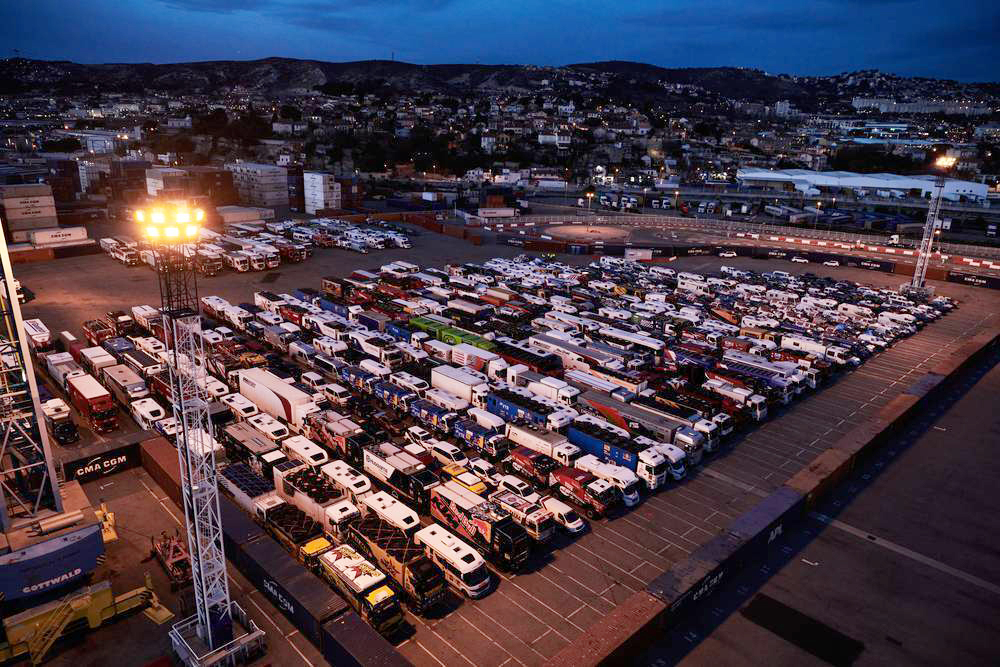
75 autos, 42 camions, 110 motos et quads inscrits en course, pour un total de 679 véhicules auxquels on peut ajouter 8 hélicoptères et 15 containers, ont été réceptionnés par les équipes d’organisation du Dakar et les dockers marseillais.
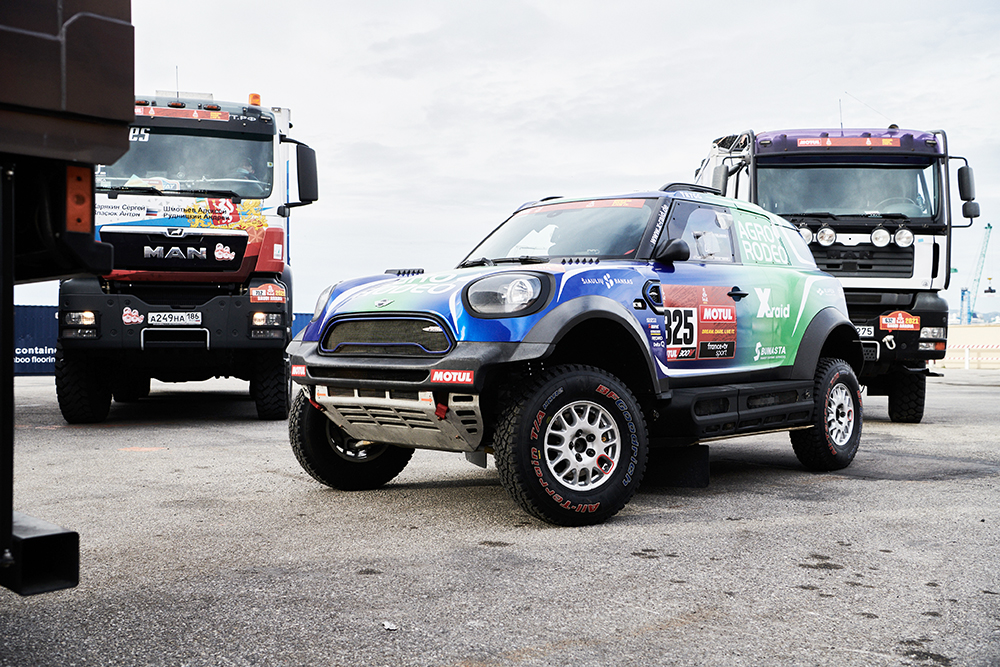
Les nombreuses restrictions de circulation qui affectent l’Europe et au-delà ont contraint les équipes participant au Dakar à une gymnastique particulière. Les concurrents, soulagés de parvenir au parc de déchargement et de voir le rallye prendre forme, avaient déjà des histoires à se raconter… sans galéjades, bien sûr !
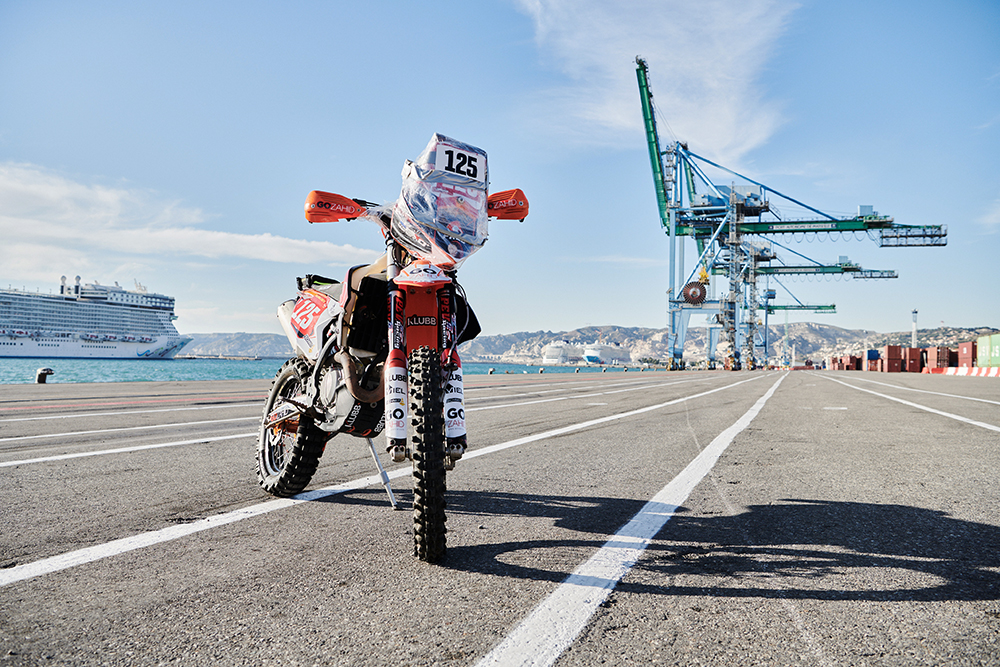
Car il flottait sur le port de Marseille comme un air d’arrivée de spéciale. Particulièrement sur le terminal Med-Europe, où étaient convoqués la plupart des véhicules du Dakar, en partance dans quelques jours pour Jeddah dans les entrailles du Garnet Leader. Car en temps de pandémie, la complexité de rassembler des convois venant de 19 pays au total tient de l’exploit administratif ! Et si la plupart des pilotes ont sagement choisi de rester à domicile, les membres de leurs équipes ont dû faire preuve de talents de navigateurs pour rejoindre la Provence, munis de leurs visas, tests PCR ou encore attestations de déplacement réservées aux sportifs de haut niveau, afin de pouvoir finalement circuler sur les routes françaises. Sachant que les réglementations nationales de protection face au virus Covid-19 varient à travers l’Europe et au-delà, c’est un roadbook d’un style tout à fait particulier qui leur avait été transmis par les services du Dakar pour arriver… à bon port. Et pour beaucoup, c’est l’anticipation et la prudence qui ont été privilégiées. Dans ce domaine, l’Indien Ashish Raorane a été le plus appliqué, puisqu’il a quitté Mumbai il y a un mois pour l’Europe afin d’éviter tout problème de mise à l’isolement, par exemple. Les Biélorusses du Team Pitlane ont eux aussi été bien inspirés de prévoir une marge dans leur emploi du temps, puisqu’ils ont été refoulés à la frontière polonaise et ont dû faire leur entrée dans l’espace Schengen en passant par la Lituanie… un détour finalement sans conséquences mais qui a déjà augmenté légèrement le kilométrage.
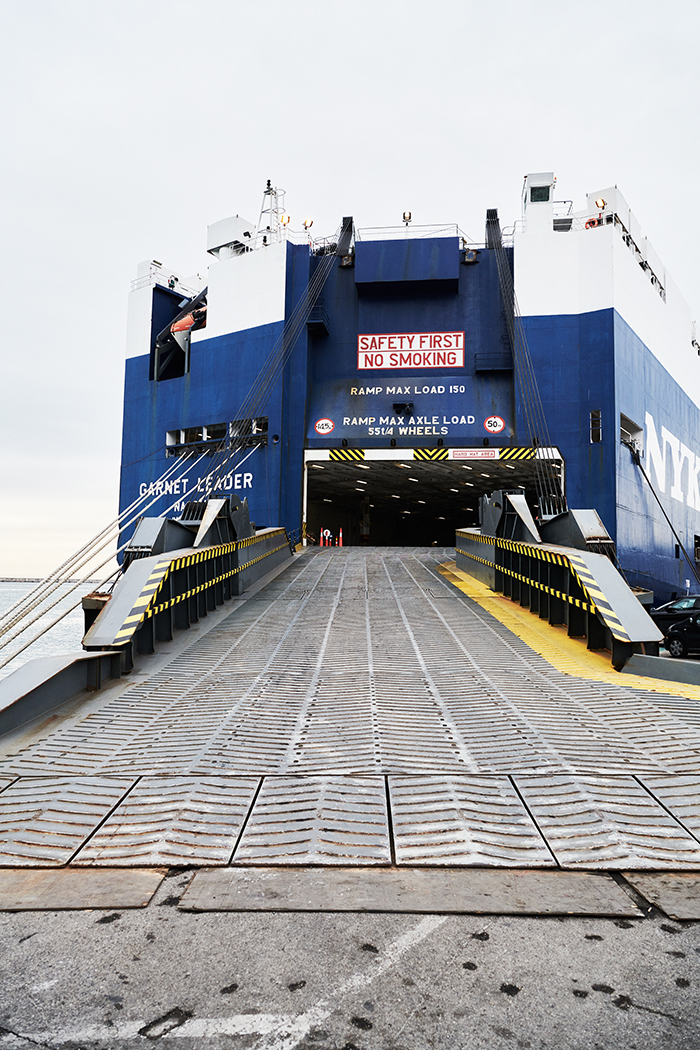
Chez Kamaz, on ne craint pas les kilomètres. Leurs camions, de course comme d’assistance, ont déjà parcouru près de 5 000 km pour venir du Tatarstan, avec leur patron Vladimir Chagin comme chef de convoi, particulièrement prolixe en anecdotes à son arrivée à Marseille : « c’est la 43e édition du Dakar, et le chiffre 43 a toujours été un porte-bonheur pour moi. D’ailleurs l’année de mes 43 ans, nous avions trois de nos camions sur le podium à l’arrivée du Dakar. Cette année, c’est notre 30e participation, j’espère que nous pourrons faire aussi bien ». En Arabie Saoudite, le « Tsar » pourra poursuivre ses récits, par exemple lors de son anniversaire le 5 janvier, qu’il a si souvent fêté par une victoire d’étape au bivouac. Il y a fort à parier que les camions bleus joueront à nouveau les premiers rôles pour les 50 ans de Chagin…
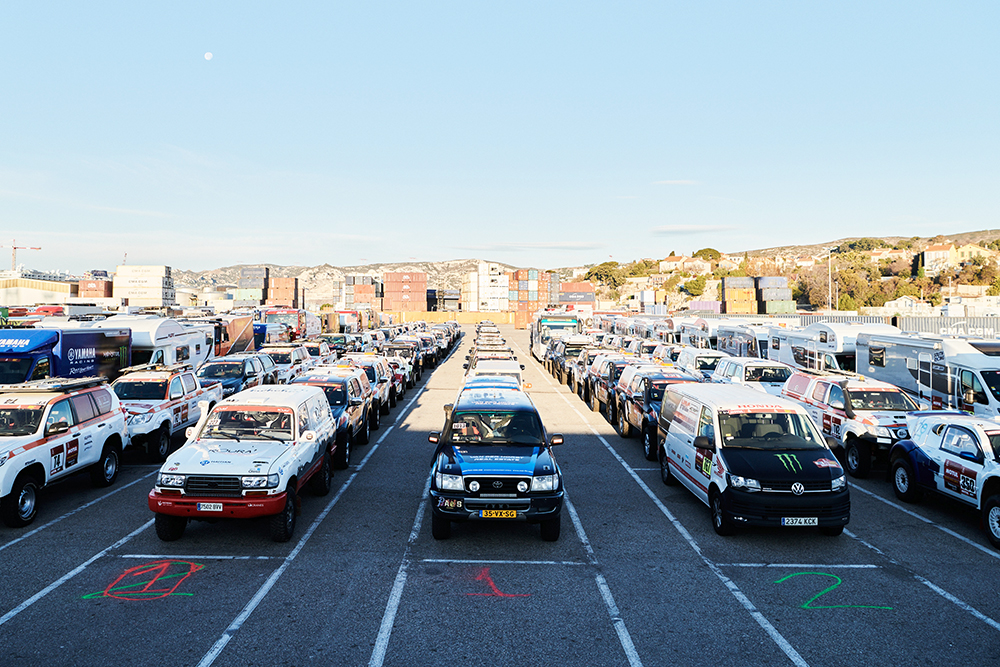
Pht. Dakar – Nicolas Prado
Video : Youtube and Dailymotion Dakar
Information in English
2021 DAKAR: A WINNING START
The details of the 43rd edition of the Dakar, which will be held in Saudi Arabia this coming January 3rd to the 15th, were announced this morning via a presentation programme shared on the event’s digital platforms and picked up by its primary broadcasters. A route of 7,646kms starting and finishing in Jeddah, including 4,767 kms of special stages, will allow the competitors to battle amongst themselves and continue the exploration of the Saudi deserts begun last year.
The 2021 course, which features all-new special stages, strives to reduce the length and amount of fast sections, while emphasising driving technique, as well as crossing and navigation skills. A marathon stage will test the equipment management and endurance qualities of the competitors immediately following the rest day in Ha’il.
Despite the difficulties associated to the health crisis, a strong field of competitors have answered the call, with 321 vehicles on the entry list. In addition to the 108 motorbikes, 21 quads, 124 cars and SSVs and 42 trucks expected at the start, 26 vehicles have been entered for a regularity competition in the new « Dakar Classic » category, open to cars and trucks built prior to 2000.
“We often hear that participating in the Dakar is a victory in itself. This is certainly the feeling that will invigorate us all on January 3rd in Jeddah », underscored David Castera as he begun the presentation of the 2021 Dakar. The preparation and in particular the reconnaissance, had to be conducted according to a schedule adapted to the 2020 travel restrictions. Similarly, the rally will be held under unusual conditions drafted in a protocol designed to ensure maximum protection against the spread of the Covid-19 virus. But for rally-raid enthusiasts, the discipline’s biggest event will feature the ingredients that « thrill those who set off and make those who stay home dream », to quote the ethos of its creator, Thierry Sabine.
After an introduction to the Saudi deserts, the 2021 Dakar competitors will receive an even more in-depth lesson in geography. The characteristics of the route as well as the new regulations introduced aim to reduce average speed, further improve safety conditions and highlight the sporting qualities of the competitors. Specifically, the fight for the various titles at stake should put the top competitors, who are used to battling it out at the sharp end of the standings, in competition with each other. In the motorcycle category, Ricky Brabec and Honda put an end to a series of 18 consecutive victories for the Austrian firm KTM, which will return with an all-star line-up of riders to try to begin another Dakar winning streak, while the reigning quad category champion, Ignacio Casale, will set off on a new challenge in the truck category, the same class in which he discovered the Dakar in 2010. 2020 winner in the car category behind the wheel of a Mini X-Raid buggy, Carlos Sainz returns with the same ambition but maybe not with the same good fortune that allowed him to control the threat of Toyota’s Nasser Al-Attiyah. With an already lively competition between the two leading constructors, the competition will be intensified by the return of Sebastien Loeb, who, like Joan « Nani » Roma in the private BRX team, will be back. Cyril Despres and Mike Horn, who have launched a project for an alternative energy vehicle for the Dakar, will be another duo to keep an eye on. And 2019 SSV category winner, Francisco « Chaleco » López from Chile will be the man to beat, in a category where the hierarchy however is constantly changing.
While the Dakar participants will head into action on January 2nd with a short prologue (11 km) to determine the starting position of each competitor for the opening stage, they will have to go through several intermediate steps before then. A majority of the vehicles will be summoned to Marseille on December 1st, 2nd and 3rd to be loaded on to a cargo ship, direction Jeddah. The meeting on the shores of the Red Sea with the owners will take place on December 30th and 31st, while the technical and administrative checks will be conducted on January 1st and 2nd in accordance with health protection regulations, as required by the period we live in.
Marseille becomes the first bivouac …
From 1 to 3 December, the Port of Marseille hosted a great deal of race, support, media and organisation vehicles, whose first adventure awaits in the shape of a sea voyage to Jeddah, where the rally will start on 3 January.
The Dakar organisation teams and the dockers in Marseille handled 75 cars, 42 trucks, 110 motorbikes and quads on the start list of the race, along with other vehicles, totalling 679 vehicles plus 8 helicopters and 15 containers.
The wide-ranging restrictions on movement in Europe and overseas forced the Dakar teams to engage in logistical acrobatics. Relieved to make it to the unloading bay and see the rally take shape before their eyes, the competitors already had a bunch of totally not embellished stories to share !
The Port of Marseille felt a bit like the finish of a special this week, especially in the Med-Europe terminal, which handled most of the vehicles that are scheduled to take part in the Dakar and will soon set off for Jeddah nestled in the bowels of the Garnet Leader. In the age of COVID-19, bringing together convoys from 19 countries is quite the administrative feat! Although most competitors wisely decided to stay home, their team members had to put their navigational skills to work to make it to Provence with the visas, PCR tests and circulation permits for high-level athletes that enabled them to drive on French roads. In light of the fact that the measures taken to fight COVID-19 vary from country to country in Europe and overseas, the Dakar services provided them with a very special kind of roadbook to make sure they reached a safe haven. Anticipation and caution paid off. No-one beat India’s Ashish Raorane in this regard, as he travelled from Mumbai to Europe a month ago to avoid any quarantine-related problems. The Belarusian Team Pitlane were also proved right in their decision to allow ample time, as they were denied entry at the Polish border and had to enter the Schengen Area via Lithuania… which did not stop them from reaching Marseille on time, but added a few kilometres to their counter.
Kamaz are not afraid of an extra kilometre or two, or even a thousand. Their race and support trucks have already covered almost 5,000 km from Tatarstan, with team boss Vladimir Chagin leading the convoy and eager to share a few anecdotes after reaching Marseille: « This will be the 43rd edition, and 43 has always been one of my lucky numbers. We managed to put three trucks on the podium at the end of the Dakar in the year I turned 43. This will be our 30th participation. I hope we can match that performance. » Once in Saudi Arabia, the « Tsar » will be able to keep up the tradition, for example, when he celebrates his birthday on 5 January, an occasion which he has often marked with a stage win. Only a fool would bet against the blue trucks gifting Chagin a stellar performance for his 50th birthday…
Next meetings:
- 30 and 31 December: vehicle retrieval at the Port of Jeddah
- 1 January and 2 January in the morning: administrative and technical scrutineering in Jeddah
- 2 January in the afternoon: prologue and podium
- 3 January: start of stage 1
- Rally held from 3 to 15 January
- 9 January: rest day in Ha’il
- 15 January: final stage and finish podium in Jeddah
